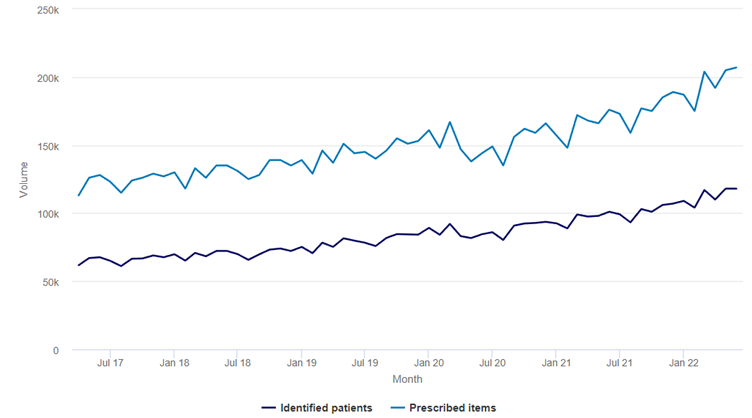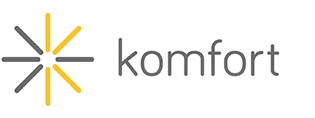ADHD & Noise: A Productivity Time Bomb
With awareness of ADHD spreading over social media, diagnoses are increasing. It’s time we take action to prepare for future generations of people who may struggle in ‘normal’ work environments. Without making changes now, businesses could suffer in the coming years.
The Rise of ADHD Diagnosis
As you can see from the graph below, since 2018 until 2022, there had been a massive increase in the number of identified patients and prescribed items for ADHD. And as of 2025, this number is closer to 270,000, with an estimated 2.6 million people with ADHD being undiagnosed.

Source: https://nhsbsa-opendata.s3.eu-west-2.amazonaws.com/mumh/mumh_quarterly_jun22_v001.html
But why?
In 2018, a tweet became viral after Dani Donovan shared a humorous drawing of how storytelling differs between those who have ADHD and those who don’t. When the tweet went out, many people related to it, and awareness of ADHD began to spread.
Fast forward to the pandemic and parents gained a front-row seat to their children’s attentional and educational struggles during their remote learning. This led to more parents realising that their child may have ADHD.
Not only children, but as adults’ own coping mechanisms broke down whilst being stuck at home, they saw ADHD symptoms relating to memory, organisation, and motivation start to show.
Simultaneously through the pandemic, TikTok downloads soared as it became the second most downloaded app of 2020. With little to do and many looking for an escape from pandemic life, there’s no surprise TikTok became a saviour to many. It, therefore, became the place to spread awareness of ADHD symptoms and how to manage it.
Is ADHD Just a Trend?
You’ve probably seen it, right? Every third video on your FYP is telling you that you’ve got ADHD. But is this just a trend or is it shining a light on a mental condition that is actually more common than we thought?
This Google trends graph shows a huge increase in searches for ADHD from 2018 to 2025 with a dramatic increase starting from around the time of the pandemic in 2020. As more awareness is being spread on social media, more people seem to be searching for symptoms in an attempt to understand themselves more and get the attention they need.

According to ADDitude Magazine, a worldwide trusted resource for families and adults living with ADHD, 26% of their readers received a formal diagnosis during the pandemic with many starting to take medication for the first time. Their readers explained how after watching several people on TikTok talking about ADHD, they realised they weren’t alone in their struggles and a lot of what they were going through could be explained.
Due to the boom of TikToks spreading awareness of ADHD symptoms (there are currently over 4 million tags of #adhd!) maybe, finally, changes will be made in modern-day life to accommodate those who of us who are neurodiverse.
ADHD & Hypersensitivity
Hypersensitivity is having extreme sensitivity to certain senses such as touch, smell or sound. It can be easy to feel overwhelmed by a lot of information and this is a common trait in those with ADHD. Hypersensitivity symptoms may include:
- Sensitivity to bright lights
- Sensitivity to loud, abrupt noises
- Unable to concentrate in areas with loud background noise
- Easily irritated or overwhelmed by repetitive sounds
- Difficulty being in large groups of people
- Sensitivity to intense smells
- Emotional episodes
- Changes in mood
- Jewellery and clothing tags can cause extreme discomfort
Although not all people with ADHD have hypersensitivity, and not all people with hypersensitivity have ADHD, it’s a trait that is comorbid.
Noisy Workplaces Could KILL Productivity
Up until recently, many doctors and professionals would brush off certain ADHD symptoms like boredom, lack of motivation, and the struggle to stay focused as ‘laziness’. However, often with ADHD, symptoms such as hypersensitivity and being easily distracted can mean ‘normal’ work environments are counterproductive.
The symptoms of ADHD can make it challenging for adults in the workplace, just like for children in school. Distractions, procrastination and difficulty managing tasks are up there with some of the most common challenges.
Take the open office design trend. From the surface, an open office seems like a dream. It’s easy to collaborate so should be easier to get through your work, right?
Wrong.
For those with ADHD, who are neurodiverse or have hypersensitivity, open offices are basically hell on earth. Combine that with an office in the middle of a busy city and say goodbye to productivity.
Noisy work environments may not seem like a productivity killer at first, but the chaos of phone conversations, meetings, building works, and traffic can make working almost impossible for those with ADHD.
With the growing diagnoses of ADHD, should we be making more of an effort to accommodate hypersensitive people and ADHD at work?
The Risk to Businesses
When it comes to building or designing offices, acoustics and partitioning can often be an afterthought. However, from the data in this article, it’s clear that not paying attention to the acoustics of an office is a ticking time bomb for businesses.
If more adults than ever before are noticing ADHD tendencies in themselves, it’s only a matter of time before children and teenagers are being diagnosed too. Hypersensitivity is a common symptom, and so can lead to a lack of productivity and motivation in the workplace, causing businesses to fall behind on deadlines. This can cause a domino effect on the satisfaction of a business’s customers.
People with ADHD can experience distress due to certain sounds in the office. This can often feel overwhelming and may lead to increased distress and anxiety. Sound triggers are different for everyone and come at varying degrees of intensity, but when a sound becomes so overwhelming that a person feels too anxious to come to work, it can be a harmful continuous cycle for both the person with ADHD and the business.
Why Businesses and Architects Should Invest in ADHD-Friendly Workspaces
With ADHD gaining more awareness and more people being diagnosed with the condition, businesses must act now to prepare for the next generation of workers. Not only will this ensure workers feel comfortable in the office, but it will also ensure more work gets done, meaning targets are more likely to be hit.
Essentially, businesses could suffer if they don’t make changes now.
Acoustic partitioning provides a solution for unwanted noise and a way for people who need it to break away from the hustle and bustle of the bullpen. These partitions reduce reverberation levels by absorbing the sounds that people with ADHD and sound sensitivity may find distracting, irritating or overwhelming. This means in open-plan offices, there is the option of meeting rooms, private offices, and break-out rooms where noise is less likely to be an issue.
Using partitions in open-plan offices can also help reduce visual stimulation, which can reduce overwhelming feelings and create a space for employees to work uninterrupted.
With so many products available as a solution to the acoustics, noise pollution and other stimulations in offices, there’s no excuse for businesses and architects not to consider those who are neurodivergent. The increase in diagnoses alone shows that awareness is spreading, and as ADHD tends to be genetic, why wouldn’t businesses want to prepare for the future?

